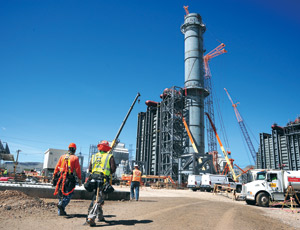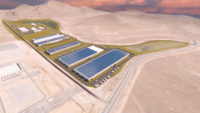NV Energy is making a power play by more than quadrupling the output of its 16-year-old southern Nevada powerplant, the 144-MW Harry Allen Generating Station. Once used as a facility for peak-time power use, the simple-cycle natural gas-fired plant is now undergoing a $600-million expansion that will increase capacity to 628 MW.

“After California’s energy crisis, we needed to become self-sufficient and not dependent upon others,” says Andrew McNeil, NV Energy’s new generation corporate executive. “At the time, we had been buying about 75% of our power from the grid.”
Las Vegas-based NV Energy’s service area covers 44,424 sq miles and includes 2.4 million residents. Located 25 miles northeast of downtown, the generating station is expected to start commercial operation this summer.
The project, begun in 2007, will add two General Electric 7FA+e hydrogen-cooled combustion gas turbines and a heat-recovery exhaust system to produce steam for a General Electric D11 steam turbine to make additional electricity. The facility will have a 55% fuel-to-power conversion rate, with an ultra-low emission rate of 2 parts per million nitrogen oxide and 2 ppm carbon monoxide. The Centennial, Colo., office of The Shaw Group Inc. is the engineering-procurement-construction contractor; San Antonio, Texas-based Zachry Engineering is the owner’s engineer.
“Harry Allen will have one of the lowest emission rates for a combined-cycle plant in the country,” says NV Energy project manager Nitin Luhar, who notes that its new emission allowances are 25% lower than what is permitted at its other combined-cycle plants. “As part of corporate culture, we feel it’s important to be good stewards of the earth and take a leadership role in protecting the environment,” Luhar says.
Water use is minimized through an air-cooling system that works like a giant radiator. The 100-ft-tall steel-framed structure consists of three dozen 36-ft-dia fans that condense steam back into water for plant reuse, thereby eliminating the need for evaporative cooling that otherwise would add 10 micrometers of particulate matter emissions. A conventional plant uses more than 600 gallons of water for each megawatt produced, whereas Harry Allen will produce the same amount of electricity using a mere 32 gallons of water.
There is no water discharged offsite. A Siemens reverse osmosis 784,800-gpd microfilter treatment facility onsite recycles 98% of plant wastewater, with the remainder going into a pair of refurbished 2.5-acre geo-textile, riprap-lined evaporation ponds. As a result, Harry Allen will use less than 200 acre ft of water annually.
The project’s environmental efforts also entailed converting an unused storage tank onsite to hold 4.7 million gallons of water. Wildlife protection efforts included a 2-mile access road and six special crossings to protect the endangered desert tortoise.
The turbines, weighing up to 883,326 lb each, required a 27-month lead time to manufacture and deliver. After being transported to within 5 miles of the jobsite via rail, the turbines were transported by heavy lift specialist Mammoet USA, Rosharon, Texas, using a specially configured crane and multi-axle truck trailer. A half dozen Mantiwoc and Demag crawler boom cranes—the biggest capable of hoisting 660 tons—picked and set pieces into place atop a 5-ft-thick, 30,000-cu-yd mat foundation with spread footings for stiff support against turbine vibration.
The project requires 137,000 cu yd of excavation and 850 tons of structural steel. Six modular pre-wired, insulated pipe racks and 174,000 miles of underground cables connect plant components together, including Vogt heat recovery steam generators and a pair of 18-ft-dia, 185-ft-tall metal exhaust stacks. There are 12 miles of piping in total, requiring 587,300 hours of welding.
In total, 750 craftspeople onsite logged more than 3 million hours of work. “Organizing and managing the labor force is the project’s biggest challenge,” says Shaw executive director Robert Follett. “We self-performed most of the work, which gives us better control over quality, schedule and safety.”
Other plant pieces include a 525-kV step-up transformer, a switchyard and a single-story concrete-block administration building.
ON Line, a $510-million, 235-mile-long transmission project due for completion in 2012, will enable the plant to transmit up to 600 MW of power to northern Nevada.
Article toolbar

Post a comment to this article
Report Abusive Comment